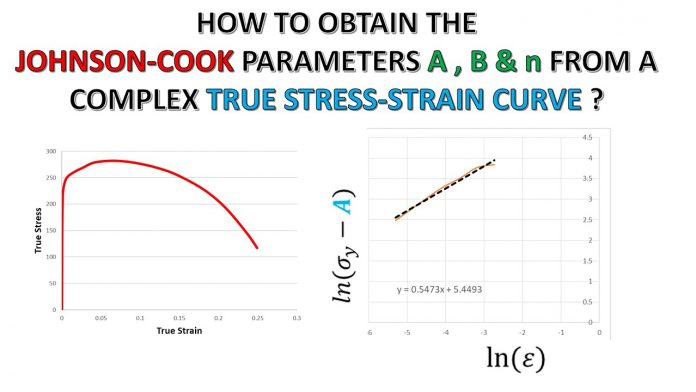What is a Stress-Strain Graph?
Sometimes it is difficult to determine the Johnson Cook parameters for a material. This can be due to variations in the stress-strain data, or physical properties that are not easily describable using linear elasticity theory.
One way to find Johnson Cook parameters is to use a stress-strain graph. A stress-strain graph plots the stress (in MPa) against the strain (in %) over time. The line that best describes the data points represents the Johnson cook parameter.
To create a stress-strain graph in Excel, first gather your data:
1. Open Excel and select File > Open. Locate your sample stress-strain data file and click Open.
2. On the Data tab of Excel, select Range > Get DataPoints(). This will open a dialog box containing your data points. You can choose any column you want to include in your graph (Stress, Strains), and you can enter any values into corresponding cells (MPa, %). Click OK to close the dialog box.
3. On the Graph axes tab of Excel, click Insert > Axes > Polar Axis > Right Angle Polar Plotting Dialog Box . This will open a dialog box prompting you for values for R1 and R2:
4. Type 100 in cell R1 and 0 in cell R2 , and then click OK to close the dialog box:
5. Drag the blue slider boundary markerically across each
How to find Johnson Cook Parameters by using Stress-Strain Graph explained through Excel Sheets?
Layout of the Stress-Strain Graph
In this tutorial, we will be exploring how to find Johnson Cook parameters using a stress-strain graph. The stress-strain graph is a graphical representation of the relationship betweenstress and strain in an object.
To create the stress-strain graph, we will first need to gather data on the properties of interest. In this example, we are interested in the properties of a beam under load. To do this, we will use a simple model where we assume that the beam is initially in equilibrium and then subjected to a load.
The spreadsheet used for this tutorial can be found here: https://docs.google.com/spreadsheet/ccc?key=0AjNvu7v_8WdHpNWVyelJGFhZ2VydGhk#gid=0
The first row of the spreadsheet contains data on the properties of interest (in this case, material properties). The second row contains data on the applied load (in Newtons). The third row contains data on the corresponding strains (in percent).
Next, we need to create a graph based on these data. To do this, we start by selecting all data in Rows 1-3 and Columns A-D (including duplicates). We then use GraphPad Prism to create a stress-strain graph (see figure below).
The first thing to note about the
How to use the Stress-Strain Graph to find Johnson Cook Parameters?
In this blog post, we will be explaining how to use the Stress-Strain Graph to find Johnson Cook Parameters by using Excel Sheets. The Stress-Strain Graph is a graphical representation of stress and strain in a material under various loading conditions. By plotting the points on the graph, we can see the relationship between stress and strain under different loading conditions.
We will be using the Excel Sheets software to generate the Stress-Strain Graph for a sample piece of metal with three different loading conditions: 1) Normal Loading (0% load), 2) Overloading (50% load), and 3) Fully Loaded (100% load). The results of our analysis will help us find out the optimal loading condition for our metal sample.
How to create a Stress-Strain Graph in Excel?
Creating a Stress-Strain Graph in Excel is an effective way to understand how a material responds to stress and strain. In this tutorial, we will show you how to create a stress-strain graph in Excel.
1. Open the Excel spreadsheet that contains the data you wish to analyze.
2. Click on the tool tab that corresponds to the type of information you would like to graph: Columns, Rows, or VLOOKUP/HLOOKUP (depending on what type of data you have).
3. In the Columns section, select the column you would like to use for your data and drag it over into the worksheet adjacent to your data.
4. In the Rows section, select the row number where you would like your graph start and drag it over into place next to your column.
5. If needed, change the X-axis range by clicking on its arrow in the lower right corner and dragging it up or down as needed. The default range is A1:C1000 (corresponding with columns A through C).
6. To add vertical axes, press CTRL+V (or choose View->Columns->Add Vertical Axis) and enter values for Y-axis (width) and X-axis (height). You can also adjust their ranges as needed by clicking on their arrows in the lower right corner and dragging them up or down as desired.
7. Add any other necessary graphs by
conclusion
There is a way to find Johnson Cook parameters by using the stress-strain graph. This is a graphical representation of the stress-strain relationship between two materials. The graph can be used to find the elastic modulus and yield strength of materials.
To find the elastic modulus, you will need to start at the bottom left corner of the graph and move up until you reach the point where the line crosses the y-axis. From this point, you will take the slope of the line and use that number as your elastic modulus.
To find the yield strength, you will need to start at one of the points on either side of where the line crosses the y-axis. From this point, you will move along the y-axis until you reach a value that is higher than your Elastic Modulus value. This value will be your yield strength.
